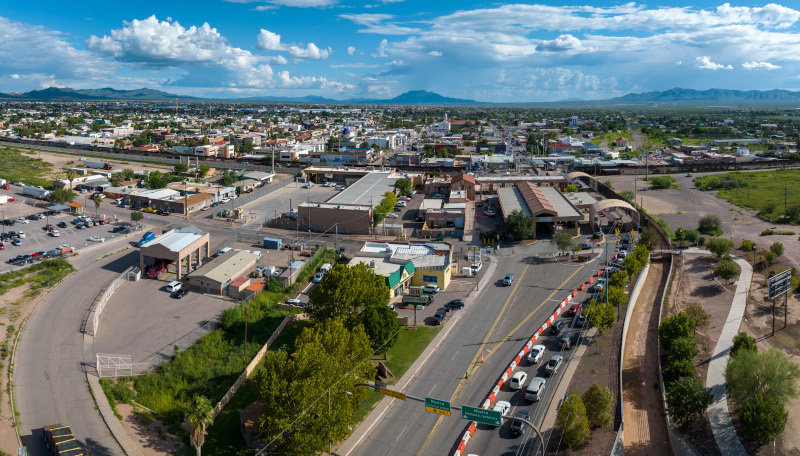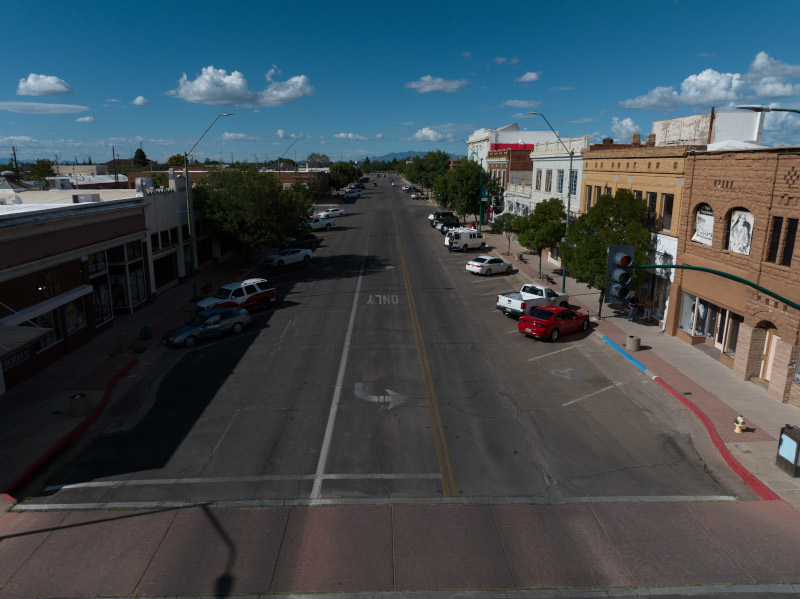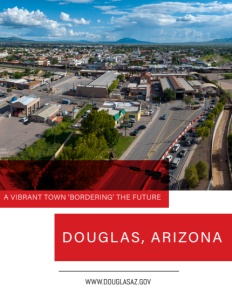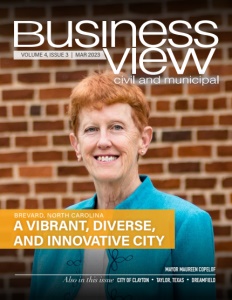Douglas, Arizona
a vibrant town ‘bordering’ the future
With unparalleled Port of Entry upgrades, Douglas, Arizona welcomes increased border traffic
A border town poised for the future, Douglas, Arizona is growing to meet the increasing cross-border demands while continuing to provide a community, laid-back quality of life for its proud residents. The town represents one of many that lie just across the US southern border, however, it can be argued that Douglas stands out among its peers when it comes to providing solid amenities and a family-friendly appeal.
There are 50 locations along the 1,969-mile U.S.-Mexico border where people can legally cross. Twenty-five of these gateways between the two countries are designated as Points of Entry (POEs), under the jurisdiction of the U.S. Customs and Border Protection agency. Arizona is home to six LPOEs – Land Ports of Entry, and the town of Douglas, a city in Cochise County, some 120 miles southeast of Tucson, is an LPOE that shares, not only the border with its sister city to the south, Agua Prieta, Mexico, but also its history, culture, and economy.
Douglas, with a current population of 16,534 was originally incorporated in 1905 and named after mining pioneer, James Douglas. For most of the 20th century, the town served as a smelting location for ore from the copper being mined in the nearby Mule Mountains. “Because we were downhill, it was natural for us to receive the cars down here,” notes Mayor Donald Huish. Unfortunately for the city, and it’s 160 residents who worked there, the smelting plant closed in 1987, and all its employees were furloughed. “So that affected our economy negatively. The movement that bridged the gap was on the Mexican side of the equation.”
Agua Prieta is a city of over 90,000 that shares with Douglas what is known as maquiladoras, or twin plants — factories that are largely duty- and tariff-free entities. On the Mexican side, workers assemble products to export back to their sister plants in the United States, where they are packaged and shipped. Maquiladoras allow companies to capitalize on the less expensive labor force in Mexico and also receive the benefits of doing business in the United States. “So that is what helped to provide jobs on our side, as well as the economic impact of people buying goods and services on this side of the border,” says Huish.
That being said, Huish goes on to explain that most of Douglas’ workers in the 21st century are actually employees of the federal government — people that operate its LPOE, customs agents, and those who work for the Department of Homeland Security’s border patrol. For years, Douglas has been planning a major renovation of its LPOE facilities and according to the federal government’s General Services Administration (GSA) feasibility study, a two-port solution was recommended a while back.
“We would move the commercial traffic outside our current city limits (which, hopefully, within the next year would be within our city limits), to a place 4.5 miles west,” says Huish. “Then, we would also remodel the existing port of entry to better handle vehicles, tour buses, pedestrians, bicycles, etc. that cross the border on a day-in, day-out basis.” In 2020, the governments of the U.S. and Mexico jointly agreed to coordinate plans on both sides of the border, after conducting an exchange of Diplomatic Notes.
Huish relates that the city was put on a priority list, but never received the necessary funding to go ahead until the final passage of the 2021 Infrastructure Investment and Jobs Act (IIJA), also known as the Bipartisan Infrastructure Bill.

“We knew that we needed a modernization of our Port of Entry,” he states.
“We’ve been trying to emphasize the need to our elected representatives for an upgrade. We feel that the economic impact is suffering because of the condition of the existing port and its configuration. When they passed the major Infrastructure Bill, we were finally on that funding list to receive 400 million dollars. So, this will be the most modern, state-of-the-art, Land Port of Entry in the United States on either border, north or south. It means a lot in terms of efficiency in importing and exporting goods. It will benefit not only our city, but the county that we live in, all the surrounding area, Arizona, and the entire southwest.”
Since the announcement of the project’s major funding, the City of Douglas, along with its partners, has worked on planning the necessary utilities and infrastructure for the new port. In December 2022, Arizona Governor, Doug Ducey, announced the allocation of another $8.9 million grant from the American Rescue Plan Act in order to support water initiatives for wastewater, groundwater, and storage.
The construction of the commercial Port of Entry is anticipated to begin in 2025, and the project is expected to be completed in 2028. “We’re being told by GSA and our Mexican counterparts that the team that we have set up, and our approach to all this, has been key to making this run smoothly and they’re taking some of the lessons on how we’re doing things to other areas when it comes times for them to expand their Ports of Entry,” Huish exclaims.
In anticipation of expansive growth in Douglas and surrounding areas when the new LPOE is complete, Huish says the city is looking to improve other aspects of its aging infrastructure.
“Water is very key to us in Arizona. We’re having to retrofit wells; we’re looking at new wells to add additional capacity. We don’t have an issue right now; the water is still plentiful; it’s good water. But we understand that we need to be proactive in making sure that our infrastructure doesn’t get out of date and we have an emergency. A lot of our water valves throughout the city are very, very old, especially in the original town site – they’re a hundred years old. So, we’re trying to be proactive in replacing those rather than waiting for them to erupt in the middle of the intersection.”
“Streets are also a big challenge,” he continues. “We did a study here two years ago. It came back to $67 million to redo all our streets. That’s so far out of reach; our bonding capacity is upwards of $12 million. It was quite sad. So, we’re looking at some grants from the federal government to do, at least, our main travel roads, our truck routes. Some of our streets got chewed up during the building of The Wall by heavy trucks. We were scheduled to get some relief funding from that project.”
He adds that “the new administration pulled out and that set us back a little bit. But we do have lobbyists in Washington D.C. and consultants in Arizona. So, in creating this infrastructure, we not only have to look at what’s existing, but we’re also looking towards the future because, with this new commercial Port of Entry, we expect our economy and our population to be growing. So, we want to make sure that we plan this out strategically and wisely to be able to handle that growth and development.”

Huish says that Douglas is actively searching for new businesses to set up shop in town. The city has its own economic development team and also relies on the assistance and expertise of the state’s Commerce Authority, as well as the federal government’s Small Business Administration (SBA). “We have them down here on a regular basis, offering advice for developing business plans for small businesses to try to get them to be successful,” he shares.
The city also has a strong relationship with nearby Cochise Community College, which is eager to provide training for the new workers who will be employed by future businesses. “The president of the college meets with us regularly and is more than ready and wants to gear up. ‘You tell me what kinds of jobs are coming, and we’ll develop teaching programs to be able to handle that,’ he says. They already started commercial driver’s license classes. ‘If you tell us you need people that understand operations, logistics, warehousing, just let us know and we’ll develop the curriculum to prepare the workforce.’”
Another current and future economic driver in Douglas is tourism. “Our area is steeped in old ‘wild west’ type history,” Huish says. “Texas John Slaughter, who was a Marshal in Tombstone, started in a ranch east of town, which is now open to tour the grounds. There’s our Vietnam War Museum in the old Gadsden Hotel that’s grown to include some of the other conflicts and wars that we’ve been in throughout the world and it’s dedicated to people who have served our wonderful, patriotic community. It’s been visited by people from all around the world. We’re also working with a developer for a new RV park, and we’re also very interested in medical tourism. We’re hoping to capitalize on that.”
Going forward, Huish says that Douglas is actively planning for the future.
In addition to the new LPOE, the city has commissioned a hotel study, and a housing study, and is working to revamp its zoning codes to allow for new ideas in construction as well as the rehabilitation of existing structures. In January of 2022, just a few months after the announcement of the commercial LPOE funding allocation, the Mayor and the City Council met to establish Douglas Vision 2032, a collection of six policy priorities to focus on as they set their sight to the future, looking from a lens that considers the impacts from this major project for the community. They include Downtown Revitalization, Infrastructure, Streets & Roads, Economic Development, Growth and Annexations, and Community Facilities & Special Events.
But, in the end, Huish says that what really drives him is working each day to renew the city’s spirit.
“There have been many years in this town when we haven’t had much hope,” he reveals. “I want Douglas to improve, but I don’t want us to forget about our past. The past is very important; it teaches us the many sacrifices that the people who came before us made, and it’s our responsibility to move our community forward for the following generation, so they can make this community even better. I was born and raised here and what gets me up each day is the desire to help. My greatest accomplishment would be to bring hope back to Douglas.”
AT A GLANCE
Douglas, Arizona
What: Dynamic Border Town welcoming increased commercial traffic with Federal Port of Entry upgrades
Where: Cochise County, Southern Arizona
Website: https://www.douglasaz.gov/
PREFERRED VENDORS
Cox Communications – https://www.cox.com
Cox expanded internet services power prosperity in Cochise County
As a longtime Southern Arizona broadband provider and community partner, Cox Communications is invested in the continued success of our neighbors in Cochise County. From network upgrades to affordable internet programs, we are committed to providing robust and reliable broadband services across the region so everyone has access to the advantages connectivity brings.
Public/private partnerships are a powerful tool for bridging the digital divide and Cox is proud to work with the City of Douglas. Together, we recently announced our plan to bring gigabit internet speeds and other services to nearly 8,000 residents and businesses in the area – including the Douglas Campus for Cochise College.
Working towards digital equity, Cox is making private investments and leveraging federal funding opportunities to power the next generation of internet users. Over the next three years Cox has committed $400 million to expand service in underserved communities. In Arizona, Cox has helped nearly 140,000 households with our affordability and digital equity programs.
At Cox, connectivity is at the heart of everything we do. From economic development to education to social support, we remain steadfast in our commitment to be the internet provider Douglas can count on to make those valuable connections a reality.
Lisa Lovallo, an Arizona native, is the Southern Arizona market vice president for Cox Communications, leading a team of 250+ local Cox employees. Reach her at lisa.lovallo@cox.com.
JW Resources LLC – jwhitman@jwresourcesllc.com



